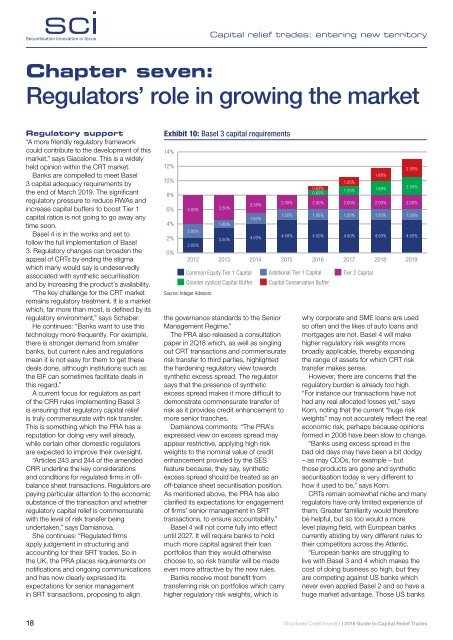SCI Regulatory CapitalRelief Research Report
Create successful ePaper yourself
Turn your PDF publications into a flip-book with our unique Google optimized e-Paper software.
Securitisation innovation in focus<br />
Capital relief trades: entering new territory<br />
Chapter seven:<br />
Regulators’ role in growing the market<br />
<strong>Regulatory</strong> support<br />
“A more friendly regulatory framework<br />
could contribute to the development of this<br />
market,” says Giacalone. This is a widely<br />
held opinion within the CRT market.<br />
Banks are compelled to meet Basel<br />
3 capital adequacy requirements by<br />
the end of March 2019. The significant<br />
regulatory pressure to reduce RWAs and<br />
increase capital buffers to boost Tier 1<br />
capital ratios is not going to go away any<br />
time soon.<br />
Basel 4 is in the works and set to<br />
follow the full implementation of Basel<br />
3. <strong>Regulatory</strong> changes can broaden the<br />
appeal of CRTs by ending the stigma<br />
which many would say is undeservedly<br />
associated with synthetic securitisation<br />
and by increasing the product’s availability.<br />
“The key challenge for the CRT market<br />
remains regulatory treatment. It is a market<br />
which, far more than most, is defined by its<br />
regulatory environment,” says Schaber.<br />
He continues: “Banks want to use this<br />
technology more frequently. For example,<br />
there is stronger demand from smaller<br />
banks, but current rules and regulations<br />
mean it is not easy for them to get these<br />
deals done, although institutions such as<br />
the EIF can sometimes facilitate deals in<br />
this regard.”<br />
A current focus for regulators as part<br />
of the CRR rules implementing Basel 3<br />
is ensuring that regulatory capital relief<br />
is truly commensurate with risk transfer.<br />
This is something which the PRA has a<br />
reputation for doing very well already,<br />
while certain other domestic regulators<br />
are expected to improve their oversight.<br />
“Articles 243 and 244 of the amended<br />
CRR underline the key considerations<br />
and conditions for regulated firms in offbalance<br />
sheet transactions. Regulators are<br />
paying particular attention to the economic<br />
substance of the transaction and whether<br />
regulatory capital relief is commensurate<br />
with the level of risk transfer being<br />
undertaken,” says Damianova.<br />
She continues: “Regulated firms<br />
apply judgement in structuring and<br />
accounting for their SRT trades. So in<br />
the UK, the PRA places requirements on<br />
notifications and ongoing communications<br />
and has now clearly expressed its<br />
expectations for senior management<br />
in SRT transactions, proposing to align<br />
Exhibit 10: Basel 3 capital requirements<br />
14%<br />
12%<br />
10%<br />
8%<br />
6%<br />
4%<br />
2%<br />
0%<br />
4.00%<br />
2.00%<br />
2.00%<br />
2012 2013 2014 2015 2016 2017 2018 2019<br />
Common Equity Tier 1 Capital Additional Tier 1 Capital Tier 2 Capital<br />
Counter cyclical Capital Buffer<br />
Source: Integer Advisors<br />
3.50%<br />
1.00%<br />
3.50%<br />
2.50%<br />
1.50%<br />
4.00%<br />
2.00%<br />
the governance standards to the Senior<br />
Management Regime.”<br />
The PRA also released a consultation<br />
paper in 2Q18 which, as well as singling<br />
out CRT transactions and commensurate<br />
risk transfer to third parties, highlighted<br />
the hardening regulatory view towards<br />
synthetic excess spread. The regulator<br />
says that the presence of synthetic<br />
excess spread makes it more difficult to<br />
demonstrate commensurate transfer of<br />
risk as it provides credit enhancement to<br />
more senior tranches.<br />
Damianova comments: “The PRA’s<br />
expressed view on excess spread may<br />
appear restrictive, applying high risk<br />
weights to the nominal value of credit<br />
enhancement provided by the SES<br />
feature because, they say, synthetic<br />
excess spread should be treated as an<br />
off-balance sheet securitisation position.<br />
As mentioned above, the PRA has also<br />
clarified its expectations for engagement<br />
of firms’ senior management in SRT<br />
transactions, to ensure accountability.”<br />
Basel 4 will not come fully into effect<br />
until 2027. It will require banks to hold<br />
much more capital against their loan<br />
portfolios than they would otherwise<br />
choose to, so risk transfer will be made<br />
even more attractive by the new rules.<br />
Banks receive most benefit from<br />
transferring risk on portfolios which carry<br />
higher regulatory risk weights, which is<br />
1.50%<br />
4.50%<br />
0.63%<br />
0.63%<br />
2.00%<br />
1.50%<br />
4.50%<br />
Capital Conservation Buffer<br />
1.25%<br />
1.25%<br />
2.00%<br />
1.50%<br />
4.50%<br />
1.88%<br />
1.88%<br />
2.00%<br />
1.50%<br />
4.50%<br />
2.50%<br />
2.50%<br />
2.00%<br />
1.50%<br />
4.50%<br />
why corporate and SME loans are used<br />
so often and the likes of auto loans and<br />
mortgages are not. Basel 4 will make<br />
higher regulatory risk weights more<br />
broadly applicable, thereby expanding<br />
the range of assets for which CRT risk<br />
transfer makes sense.<br />
However, there are concerns that the<br />
regulatory burden is already too high.<br />
“For instance our transactions have not<br />
had any real allocated losses yet,” says<br />
Korn, noting that the current “huge risk<br />
weights” may not accurately reflect the real<br />
economic risk, perhaps because opinions<br />
formed in 2008 have been slow to change.<br />
“Banks using excess spread in the<br />
bad old days may have been a bit dodgy<br />
– as may CDOs, for example – but<br />
those products are gone and synthetic<br />
securitisation today is very different to<br />
how it used to be,” says Korn.<br />
CRTs remain somewhat niche and many<br />
regulators have only limited experience of<br />
them. Greater familiarity would therefore<br />
be helpful, but so too would a more<br />
level playing field, with European banks<br />
currently abiding by very different rules to<br />
their competitors across the Atlantic.<br />
“European banks are struggling to<br />
live with Basel 3 and 4 which makes the<br />
cost of doing business so high, but they<br />
are competing against US banks which<br />
never even applied Basel 2 and so have a<br />
huge market advantage. Those US banks<br />
18<br />
Structured Credit Investor | 2018 Guide to Capital Relief Trades





